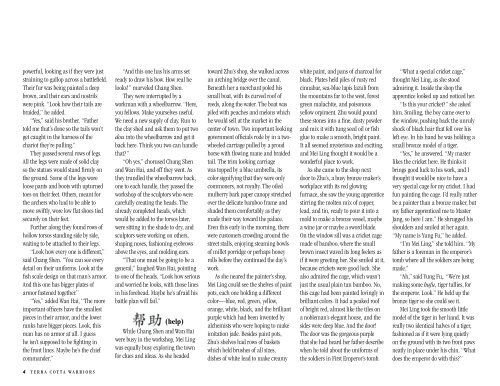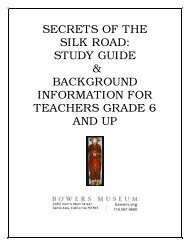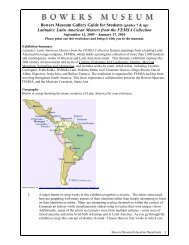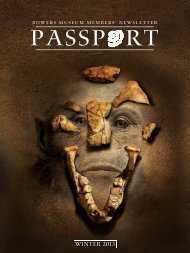A Resource Guide for Students and Teachers - Bowers Museum
A Resource Guide for Students and Teachers - Bowers Museum
A Resource Guide for Students and Teachers - Bowers Museum
You also want an ePaper? Increase the reach of your titles
YUMPU automatically turns print PDFs into web optimized ePapers that Google loves.
powerful, looking as if they were just<br />
straining to gallop across a battlefield.<br />
Their fur was being painted a deep<br />
brown, <strong>and</strong> their ears <strong>and</strong> nostrils<br />
were pink. “Look how their tails are<br />
braided,” he added.<br />
“Yes,” said his brother. “Father<br />
told me that’s done so the tails won’t<br />
get caught in the harness of the<br />
chariot they’re pulling.”<br />
They passed several rows of legs.<br />
All the legs were made of solid clay<br />
so the statues would st<strong>and</strong> firmly on<br />
the ground. Some of the legs wore<br />
loose pants <strong>and</strong> boots with upturned<br />
toes on their feet. Others, meant <strong>for</strong><br />
the archers who had to be able to<br />
move swiftly, wore low flat shoes tied<br />
securely on their feet.<br />
Further along they found rows of<br />
hollow torsos st<strong>and</strong>ing side by side,<br />
waiting to be attached to their legs.<br />
“Look how every one is different,”<br />
said Chang Shen. “You can see every<br />
detail on their uni<strong>for</strong>ms. Look at the<br />
fish scale design on that man’s armor.<br />
And this one has bigger plates of<br />
armor fastened together.”<br />
“Yes,” added Wan Hai, “The more<br />
important officers have the smallest<br />
pieces in their armor, <strong>and</strong> the lower<br />
ranks have bigger pieces. Look, this<br />
man has no armor at all. I guess<br />
he isn’t supposed to be fighting in<br />
the front lines. Maybe he’s the chief<br />
comm<strong>and</strong>er.”<br />
4 TERRA COTTA WARRIORS<br />
“And this one has his arms set<br />
ready to draw his bow. How real he<br />
looks!” marveled Chang Shen.<br />
They were interrupted by a<br />
workman with a wheelbarrow. “Here,<br />
you fellows. Make yourselves useful.<br />
We need a new supply of clay. Run to<br />
the clay shed <strong>and</strong> ask them to put two<br />
dou into the wheelbarrow <strong>and</strong> get it<br />
back here. Think you two can h<strong>and</strong>le<br />
that?”<br />
“Oh yes,” chorused Chang Shen<br />
<strong>and</strong> Wan Hai, <strong>and</strong> off they went. As<br />
they trundled the wheelbarrow back,<br />
one to each h<strong>and</strong>le, they passed the<br />
workshop of the sculptors who were<br />
carefully creating the heads. The<br />
already completed heads, which<br />
would be added to the torsos later,<br />
were sitting in the shade to dry, <strong>and</strong><br />
sculptors were working on others,<br />
shaping noses, fashioning eyebrows<br />
above the eyes, <strong>and</strong> molding ears.<br />
“That one must be going to be a<br />
general,” laughed Wan Hai, pointing<br />
to one of the heads. “Look how serious<br />
<strong>and</strong> worried he looks, with those lines<br />
in his <strong>for</strong>ehead. Maybe he’s afraid his<br />
battle plan will fail.”<br />
(help)<br />
While Chang Shen <strong>and</strong> Wan Hai<br />
were busy in the workshop, Mei Ling<br />
was equally busy exploring the town<br />
<strong>for</strong> clues <strong>and</strong> ideas. As she headed<br />
toward Zhu’s shop, she walked across<br />
an arching bridge over the canal.<br />
Beneath her a merchant poled his<br />
small boat, with its curved roof of<br />
reeds, along the water. The boat was<br />
piled with peaches <strong>and</strong> melons which<br />
he would sell at the market in the<br />
center of town. Two important looking<br />
government officials rode by in a twowheeled<br />
carriage pulled by a proud<br />
horse with flowing mane <strong>and</strong> braided<br />
tail. The trim looking carriage<br />
was topped by a blue umbrella, its<br />
color signifying that they were only<br />
commoners, not royalty. The oiled<br />
mulberry bark paper canopy stretched<br />
over the delicate bamboo frame <strong>and</strong><br />
shaded them com<strong>for</strong>tably as they<br />
made their way toward the palace.<br />
Even this early in the morning, there<br />
were customers crowding around the<br />
street stalls, enjoying steaming bowls<br />
of millet porridge or perhaps honey<br />
rolls be<strong>for</strong>e they continued the day’s<br />
work.<br />
As she neared the painter’s shop,<br />
Mei Ling could see the shelves of paint<br />
pots, each one holding a different<br />
color—blue, red, green, yellow,<br />
orange, white, black, <strong>and</strong> the brilliant<br />
purple which had been invented by<br />
alchemists who were hoping to make<br />
imitation jade. Besides paint pots,<br />
Zhu’s shelves had rows of baskets<br />
which held brushes of all sizes,<br />
dishes of white lead to make creamy<br />
white paint, <strong>and</strong> pans of charcoal <strong>for</strong><br />
black. Plates held piles of rusty red<br />
cinnabar, sea-blue lapis lazuli from<br />
the mountains far to the west, <strong>for</strong>est<br />
green malachite, <strong>and</strong> poisonous<br />
yellow orpiment. Zhu would pound<br />
these stones into a fine, dusty powder<br />
<strong>and</strong> mix it with tung seed oil or fish<br />
glue to make a smooth, bright paint.<br />
It all seemed mysterious <strong>and</strong> exciting,<br />
<strong>and</strong> Mei Ling thought it would be a<br />
wonderful place to work.<br />
As she came to the shop next<br />
door to Zhu’s, a busy bronze maker’s<br />
workplace with its red glowing<br />
furnace, she saw the young apprentice<br />
stirring the molten mix of copper,<br />
lead, <strong>and</strong> tin, ready to pour it into a<br />
mold to make a bronze vessel, maybe<br />
a wine jar or maybe a sword blade.<br />
On the window sill was a cricket cage<br />
made of bamboo, where the small<br />
brown insect waved its long feelers as<br />
if it were greeting her. She smiled at it,<br />
because crickets were good luck. She<br />
also admired the cage, which wasn’t<br />
just the usual plain tan bamboo. No,<br />
this cage had been painted lovingly in<br />
brilliant colors. It had a peaked roof<br />
of bright red, almost like the tiles on<br />
a nobleman’s elegant house, <strong>and</strong> the<br />
sides were deep blue. And the door!<br />
The door was the gorgeous purple<br />
that she had heard her father describe<br />
when he told about the uni<strong>for</strong>ms of<br />
the soldiers in First Emperor’s tomb.<br />
“What a special cricket cage,”<br />
thought Mei Ling, as she stood<br />
admiring it. Inside the shop the<br />
apprentice looked up <strong>and</strong> noticed her.<br />
“Is this your cricket?” she asked<br />
him. Smiling, the boy came over to<br />
the window, pushing back the unruly<br />
shock of black hair that fell over his<br />
left eye. In his h<strong>and</strong> he was holding a<br />
small bronze model of a tiger.<br />
“Yes,” he answered. “My master<br />
likes the cricket here. He thinks it<br />
brings good luck to his work, <strong>and</strong> I<br />
thought it would be nice to have a<br />
very special cage <strong>for</strong> my cricket. I had<br />
fun painting the cage. I’d really rather<br />
be a painter than a bronze maker, but<br />
my father apprenticed me to Master<br />
Jang, so here I am.” He shrugged his<br />
shoulders <strong>and</strong> smiled at her again.<br />
“My name is Yung Fu,” he added.<br />
“I’m Mei Ling,” she told him. “My<br />
father is a <strong>for</strong>eman in the emperor’s<br />
tomb where all the soldiers are being<br />
made.”<br />
“Ah,” said Yung Fu,. “We’re just<br />
making some hufu, tiger tallies, <strong>for</strong><br />
the emperor. Look.” He held up the<br />
bronze tiger so she could see it.<br />
Mei Ling took the smooth little<br />
model of the tiger in her h<strong>and</strong>. It was<br />
really two identical halves of a tiger,<br />
fashioned as if it were lying quietly<br />
on the ground with its two front paws<br />
neatly in place under his chin. “What<br />
does the emperor do with this?”





